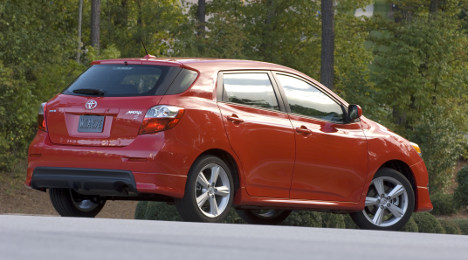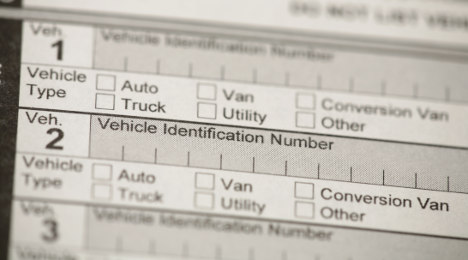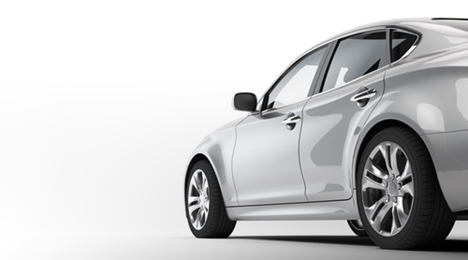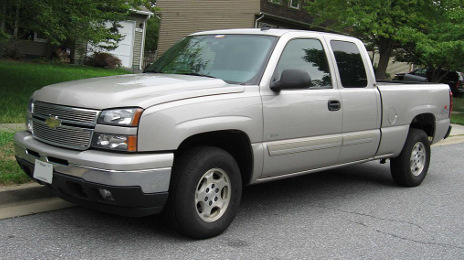Based on what Manheim’s Tom Webb observed in the first half of the month, wholesale prices appear to be down slightly in April.
In a Twitter post on Wednesday, the chief economist at Manheim Consulting said used prices in the first 15 days of the month have slowed compared to March.
It’s a bit too early to accurately pinpoint the exact amount of decline, he said, but mentioned to Auto Remarketing in an email that the change was “more than a ‘smidge,’ but less than ‘a lot.’”
In March, Manheim found that wholesale prices (on a mix-, mileage- and seasonally adjusted basis) were up 0.9 percent month-over-month.
This movement resulted in the Manheim Used Vehicle Value Index reading coming in at 124.4 for the month, an increase of 2.2 percent for the first quarter, and a rise of 3.3 percent on a year-over-year basis.
“The strength of wholesale pricing in 2014 has been consistent with the fundamentals of the retail market,” Webb said when the index was released. “In March, new-vehicle sales sprung back from a weather-induced stall in January and February. Used vehicle retail sales also picked up, even though those sales were less impacted by the harsh weather.”
The index climbed 2.2 percent sequentially during the first quarter and was up 3.3 percent from Q1 of 2013. As of late March, tax refunds had climbed 3 percent, giving consumers more purchasing power in the used-car market, Manheim explained in an analysis released earlier this month.
Another factor driving used values was the winter weather, which wielded stronger-than-usual damage to vehicles leading to higher demand for insurance replacement/loaner cars, Manheim noted. As such, rental companies put off their usual de-fleeting, Manheim indicated, holding on to these cars instead.
“Rental risk units flowing back into the wholesale market remained depressed in March after being at low levels in January and February,” Webb said in that analysis.
“The weather was the chief culprit in keeping these units out of the used-car market. Rental car companies held onto their fleets longer than normal because demand was so high in the insurance replacement segment.”
As for the full-year, wholesale prices will likely fall in light of greater supply, he noted. That said, Webb explained in the early April analysis that prices should stay hearty in the near-term given massive recalls and a late Easter, two factors that should continue to hold rental units out of the wholesale market for longer than usual.
"The end result so far has been higher prices and higher mileage vehicles in the wholesale used-vehicle market," Webb said. "By the end of the year, we expect pricing to moderate as rental units eventually make their way into the wholesale market and the acceleration in off-lease units becomes more pronounced."
Tax season ends today with the IRS tax filing deadline, and most likely, so will many seasonal price hikes in the lanes.
Black Book picked out five car segments, in particular, that are expected to see significant near-term price declines.
Every dealer is familiar with what the February through April time frame means: thousands of car-shoppers are going to use their tax rebate checks on used car purchases. Consequently, demand pushes auction prices high as the new year kicks off.
Wholesale prices rose 6 percent in March on a monthly basis and 4 percent from the same period last year, averaging $10,429, according to ADESA Analytical Services’ data.
But these unnaturally high rates don’t last for long.
Based on seasonal trends tracked by Black Book, the entry midsize car, full-size car, full-size crossover, upper midsize car and compact car segments will see the biggest price corrections as rates drop back down to normal levels.
Touting the largest expected change is the entry midsize car segment, which at the current average of $10,741, is expected to drop 5.9 percent during the May-to-July time frame.
Next up is the full-size car segment, which is expected to fall 4.2 percent from an average wholesale price of $12,920 during the same period.
The full-size cars will be followed by the full-size crossovers ($21,114) with a drop of 3.6 percent; the upper mid-size car segment ($10,995), which is expected to drop by 3.5 percent; and the compact car segment ($9,151), falling by 3.4 percent.
It seems the turn had already begun last week. Though the auction market is still holding strong overall, this past week marked the lowest level of price increases in the past four weeks, according to Black Book editorial director and senior vice president Ricky Beggs, who reported that 62 percent of rate changes were increases.
For more informaiton on last week's auction price activity, see the Auto Remarketing story here.
On Monday, Kelley Blue Book rolled out easier access to KBB values and configuration data for new vehicles by vehicle identification number (VIN), in addition to information already available by VIN for used vehicles within its suite of business-to-business solutions.
Using the new-vehicle VIN decoding feature within Kelley Blue Book's products, the company said that dealership personnel can quickly obtain all the new-vehicle information they need without having to utilize a third-party provider or other applications, allowing easy access to key Kelley Blue Book Values.
Additional information available by new-vehicle VIN includes year, make, model, engine, transmission and drivetrain information, as well as factory-installed options, standard equipment and additional optional equipment.
KBB pointed out that all information is updated weekly, ensuring market-reflective valuations are at partners’ fingertips.
Valuation data available by new-vehicle VIN includes invoice, manufacturer’s suggested retail price (MSRP) and Fair Purchase Price. Officials reiterated the Kelley Blue Book Fair Purchase Price reflects the price consumers are typically paying a dealer for a selected new vehicle in the current week.
Statistical models utilize actual transactions at the retail level from across the country to validate or revise the Fair Purchase Price every week, as market conditions and consumer trends shift.
“The latest update in our suite of industry solutions ensures that customers can easily access helpful VIN-specific data and timely, relevant Kelley Blue Book Values for any vehicle in the marketplace, whether new or used, all in one place,” said Dan Ingle, vice president of valuations and industry products for Kelley Blue Book.
“We are committed to being a dynamic business partner for our customers, leveraging Kelley Blue Book’s nearly 90 years of vehicle information and expertise to provide trusted values, unparalleled data and integration tools for both new and used vehicles,” Ingle continued.
Ingle noted that all VIN-related information is obtained from factory data, and includes manufacturer’s order codes. Kelley Blue Book also provides all associated VIN trims, if more than one is determined.
Kelley Blue Book’s industry solutions that now feature new-vehicle VIN decoding include InfoDriver Data, InfoDriver Web Service, InfoDriver Batch VIN, KARPOWER Online and Quick Values.
For more information about how to obtain vehicle configuration information and Kelley Blue Book Values via new-vehicle VIN, contact Syndication@kbb.com.
If last week’s price movement is any indicator, spikes in wholesale prices may finally be slowing down as Tuesday marks the IRS tax filing deadline.
Wholesale prices rose 6 percent in March on a monthly basis and 4 percent from the same period last year, averaging $10,429, according to ADESA Analytical Services’ data. But rates might just be getting back to normal.
Though the auction market is still holding strong overall, this past week marked the lowest level of price increases in the past four weeks, according to Black Book’s Ricky Beggs, who reported that 62 percent of rate changes were increases.
This is very much in line with what Black Book has heard from the lanes, including comment like “good but not as strong as last month” from the Texas market to go along with “steady again” out of Illinois and the “still high” all the way from Washington state, the Black Book editorial director reported in his latest “Beggs on the Used Car Market” video report.
Beggs said though tax season is over, there are two factors “holding the strength of the values up.”
First, dealers are reporting retail inventory is currently low.
Secondly, Beggs said, “The other primary factor might be now that winter weather has finally left us, dealers are anticipating an uptick in traffic within the used market, and they must have some additional inventory.”
Taking a look at the numbers, the average price for cars increased for the third consecutive week, rising $9.
This past week, seven of the 10 car segments saw prices rise, with the upper midsize cars leading the pack (up $74).
On the other hand, the prestige level cars, with a drop of $149, saw one of the biggest decreases this past week.
Trucks continue to show strong price retention with a $31 increase.
And Beggs noted, “This is the first time I can recall that all 14 truck segments were increasing week-over-week.”
Some of the strongest segments were the full-size pickups with a increase of $50, the compact SUVs with a spike of $80, and the minivan wagon segment, which rose by $45.
“When looking at year ago periods for both the cars and the trucks I am not the least bit surprised to see how much stronger we are today than a year ago where the trucks finished at +$5 and the cars only had four positive changing segments, and overall were at -$14, as these past four to five weeks this year have been amazingly strong,” Beggs said.
These increases among the truck segments is continuing a trend seen through much of 2013 and the beginning of the new year.
In the latest edition of Kontos Kommentary, Tom Kontos said pickups and SUVs experienced particularly strong year-over-year price increases this past month, with the average segment increase for trucks in March coming in at 11.2 percent.
Kontos also touched on a few contributing factors to wholesale price strength in March.
“Off-rental units, which were in greater abundance last March, were a driving factor in this March’s results. Delayed off-rental supply translated into higher off-rental prices, which in turn contributed to higher overall average wholesale used vehicle prices,” he said. “On top of that, retail used vehicle sales rebounded strongly in March, after being depressed by severe weather in January and February. The resulting strong demand also contributed to higher overall prices.”
That same severe weather might also help to push prices down in the near future.
“To the extent off-rental volume was hindered by winter conditions and a late Easter, this volume should be forthcoming soon and, along with expected off-lease volume growth, will put downward pressure on prices as seen in previous months,” Kontos concluded.
Earlier this month, NADA Used Car Guide’s Stu Zalud said he and his wife were out to purchase a vehicle and had a trade-in. The price the dealer was offering for the trade was simply on a piece of paper.
“That’s kind of how it’s always been done,” he said. “No real validation, no background, no reasoning behind how they arrived at the number.”
Thing is, when a dealer does that, here’s what tends to happen, Zalud says: the price could very well exactly what the trade-in is worth, but more often than not, the consumer won’t agree to the price, and the dealer has to pump more money into the trade to make the sale happen.
“Let’s just say that it’s $15,000 (that the trade-in is worth) and you have to more money in that car — and maybe $15,000 really is a fair market value for the car, but because the presentation is less than agreeable from the consumer’s standpoint, the number has to go up. And when the number goes up, what happens? Profit opportunity for the dealership declines, because you’re putting more money in a car that might not be worth what it is,” said Zalud, director of dealer services at NADA Used Car Guide.
It’s this type of scenario NADA UCG had in mind with AppraisalPRO, an upgraded product aiming to bring more transparency to the appraisal process and “bridge the gap” between consumers and dealers. After feedback from its own customers and studying research from Deloitte at the Detroit Auto Show, NADA UCG sought to boost the customer experience and transparency in appraisals by optimizing AppraisalPRO for tablets to engage the customer throughout the appraisal process. The tool can also be utilized on mobile phones and desktop computers, and data can be saved from one device to the next (computer, tablet, mobile phone).
AppraisalPRO was also enhanced with a photo upload and damage details sections that allow dealers to better explain and back up deductions they make on a car’s worth. There are also enhanced reporting capabilities for managing appraisals and tracking trade negotiations. The tool also allows for history reports from AutoCheck and Carfax to be integrated.
The enhanced app has been launched with existing customers already; NADA UCG is starting to market it to new customers this month.
The actual product has been on the market for several years, but Zalud explained in more detail why the company decided to enhance it.
“We had a product that was very unique — and still is unique for a lot of reasons — but we listened to what our customers had to say, and obviously the IT world changes constantly, as does software,” said Zalud. “So, about a year ago, we started to embark on a significant investment in time, effort and manpower to make some necessary changes in the design and the functionality of the tool to make it more user-friendly for dealers and even improve on what was already a pretty good product. And we did all this without raising the cost, which is significant.
“But the whole idea is that appraisals have not kept pace, from both a technology standpoint and also an experience standpoint — for the consumer, especially — with the rest of the industry. The buying process has changed; the delivery process has changed; the technology clearly has changed,” he continued. “But most dealers still approach that appraisal in an old-fashioned way.”
However, the customer-involved and explanation-centered approach that AppraisalPRO promotes — all while allowing the dealer to create his own pricing parameters — can lead to three immediate results, Zalud said.
“There is going to be less need to adjust that car to make a deal,” he said. “The consumer is going to be able to get an appraisal quicker. If you look at all the survey information that comes back from the millennials — and those folks are going to comprise over half the market here in another five or six years — they’re looking for speed.
“Everybody’s looking for transparency. It’s evident today that if there is transparency out there, you have to provide it,” Zalud continued. “And then by providing it, with real data and good data … what’s going to happen is, more times than not, the consumer is going to say, ‘Well, yeah, now you’ve shown me how you got there. You started with an NADA trade-in value and you went through all the steps of the condition with me.’”
Zalud personally suggests bringing the customer with you to walk around the vehicle during the appraisal and point out the deficiencies to give the shopper a clearer picture as to why his or her car is worth that amount. If that valuation is supported by data that is shared with the customer, that shopper is much more likely to be satisfied and agree to that amount.
Citing data from industry sources, Zalud notes that about half the time, customers are not satisfied with the appraisal process. Here’s how that plays out when it comes to numbers.
Let’s say a dealer appraises 100 cars each month. The store would most likely take in around 75 of those cars, he said.
Based on the half-dissatisfaction statistic noted above, around 37 won’t be pleased with whatever number is presented to them at trade-in time, Zalud said.
“And the average adjustment that a dealer makes today if they’re handling non-luxury products is probably $500 every time they have to go back to a desk or back to a tower or back to a manager to get a new number to save a deal,” he said. “And the average times that has to happen in a transaction is probably about one-and-a-half times.
“So that would mean you would be making a $750 addition to the starting number to put your deal together. And if you do it 37 times, that’s $27,000 a month that the dealer is actually losing from his bottom line,” Zalud continued.
He emphasized the tool won’t prevent all customers from being dissatisfied, but it can reduce that number.
“If it’s only 10 percent,” Zalud said, going to the aforementioned $27,000 cost, “10 percent is $2,700.”
And that just adds to the bottom line — money that he contends dealers are otherwise giving up.
“And they’re giving it up because the just don’t have a good process in place to support whatever they believe is the best number for that car,” Zalud said.
DealActivator Adds NADA Used Car Guide Data
In related news, Dominion Dealer Solutions announced that it has added NADA Used Car Guide data to its DealActivator equity mining product
Alan Andreu, general manager of equity solutions for Dominion Dealer Solutions, said: “We’re pleased to offer our dealers a choice for used-car values. With the addition of NADA Used Car Guide data, dealers can choose the guide they prefer. This continues DealActivator’s trend as the leader in automotive equity data mining.”
NADA Used Car Guide chief operating officer and vice president Mike Stanton added: “We worked closely with Alan and his team to meet dealer demand by providing NADA values within DealActivator. We look forward to the continuing expansion of our relationship with Dominion Dealer Solutions.”
Existing DealActivator customers can choose to use NADA Used Car Guide values at no extra charge.
It seems wholesale price spikes may be slowing down this week after March and early April showed strong retention across most segments.
This week, NADA Used Car Guide is predicting prices to remain unchanged — holding steady at an average of $17,350.
In terms of gains, the biggest percentage increase will be seen in the midsize utility segment, which is expected to grow by 0.8 percent or $175, David Paris, NADA UCG automotive analyst, reported.
Compact cars, compact utilities, large pickups and midsize cars are all expected to increase by a range of 0.2 percent to 0.6 percent.
As warmer weather spreads across the country, interest and demand for large, four-wheel-drive vehicles is waning, and the effects are being seen in the lanes.
This week, large SUVs are expected to see the biggest losses ; prices for the segment are expected to decrease by 0.7 percent (or $225) versus the two-week average.
Midsize vans are expected to see a 0.3-percent (or $50) drop, as well.
On the luxury side of the market, cars and utilities are expected to decline by 0.2 percent and 0.3 percent, respectively.
This week’s price movement marks a slowdown from what has been a tax season of high prices in the lanes.
Black Book reported Thursday that winter weather played a large role in altering seasonal patterns for vehicle depreciation.
That is, snow storms and the like delayed many buyers and vehicles from making it to auction in late winter. As a result, Black Book believes seasonal market strength has been pushed further into April than usual.
According to Black Book data, used vehicles from model years 2008 through 2012 depreciated 0.3 percent, overall, in March, showing continued strength in seasonal retention compared to the 1.1-percent drop in February.
Entry-level cars led all segments with the strongest monthly retention, gaining 2.6 percent of value, and cargo minivans led all truck segments by gaining 1.7 percent of value during March.
Entry-level cars finished March with an average wholesale value of $7,491, a 15.- percent drop from year-ago levels ($8,912).
On the other hand, prestige luxury cars led the pack for highest monthly depreciation during march with a drop of 2.1. percent.
Black Book offered the following statistic to illustrate the strong retention experienced in March.
Only three of the 24 overall segments Black Book tracks depreciated higher than 1 percent last month: Prestige luxury cars (-2.1 percent), luxury SUVs (-1.3 percent), and luxury-level cars (-1.1 percent).
“The buying season has kicked into high gear, particularly for those segments that average near $10,000 that are in high demand,” said Ricky Beggs, editorial director at Black Book. “Smaller car segments will continue to see near-term strength until late spring, when demand for these vehicles lightens and follows familiar seasonal patterns.”
Four- and two-week AuctionNet wholesale average prices are created by collecting all AuctionNet records for vehicles up to five years of age for a specified period of time. Prices are then adjusted for changes in mileage and mix.
Current week prices are based on NADA's proprietary used-vehicle value model which includes assumptions for new-vehicle prices, used-vehicle supply, gasoline prices, and other economic factors.

| NADA Segment |
Average AuctionNet® Wholesale Price |
2-Week v. Current |
| 4-Week Average |
2-Week Average |
Current Week |
% Change |
$ Change |
| Compact Car |
$11,650 |
$11,625 |
$11,700 |
0.6% |
$75 |
| Compact Utility |
$16,450 |
$16,450 |
$16,475 |
0.2% |
$25 |
| Industry |
$17,300 |
$17,350 |
$17,350 |
0.0% |
$0 |
| Large Pickup |
$23,800 |
$23,900 |
$24,025 |
0.5% |
$125 |
| Large SUV |
$31,250 |
$30,875 |
$30,650 |
-0.7% |
($225) |
| Luxury Car |
$24,050 |
$24,250 |
$24,200 |
-0.2% |
($50) |
| Luxury Utility |
$27,650 |
$27,925 |
$27,850 |
-0.3% |
($75) |
| Mid-Size Car |
$13,650 |
$13,700 |
$13,750 |
0.4% |
$50 |
| Mid-Size Utility |
$20,675 |
$20,775 |
$20,950 |
0.8% |
$175 |
| Mid-Size Van |
$17,150 |
$17,275 |
$17,225 |
-0.3% |
($50) |
NADA Used Car Guide pinpointed just how much more wholesale prices for used cars and light trucks up to 8 years in age increased in March than they did in February.
Analysts pegged the March jump at 3.7 percent, well above February’s 2.2-percent increase. NADA UCG executive automotive analyst Jonathan Banks explained what happened in the April edition of Guidelines.
“Harsh weather in January and February compelled dealers to bid aggressively and play inventory catch-up in preparation for the traditional spring bounce in consumer demand,” Banks said.
Banks also mentioned late-model volume continued to fall while dealer activity was heating up, adding further buoyancy to prices.
“These unique factors pushed NADA’s seasonally adjusted used-vehicle price index to 127.0, a new all-time high,” Banks said about the index that measures the change in used-vehicle prices up to 8 years old.
NADA UCG noted that upward price movement was greatest for the segments experiencing the biggest declines in auction volume.
The number of auction transactions for compact cars, midsize cars and midsize vans fell by respective averages of 4.5 percent, 4.9 percent and 9.7 percent. Correspondingly, analysts determined prices for the three segments improved by an average of 4.4 percent.
Analysts went on to mention the large pickup truck segment was one of the few mainstream groups to have a sales increase last month, up 5.8 percent.
“Following years of price appreciation, first-quarter results indicate little waning in demand for the large pickup segment,” Banks said.
Furthermore, Banks indicated luxury utility prices grew by an average of 1.3 percent and luxury car prices recorded a 1.2-percent lift, “which is normal for the month of March over the last five years.”
NADA UCG’s forecast for April points to prices falling 1.8 percent to 2.2 percent compared to March by month’s end, which is higher than both the 1.7-percent drop recorded in April last year and the 1.2-percent decline averaged for the month of April over the last 10 years.
“Prices are expected to be softest for many of the segments that experienced the biggest price increases in March — midsize cars, SUVs and minivans, and to a lesser extent, compact cars and compact SUVs,” Banks said.
Banks added that luxury car prices should drop “at the higher end of the predicted range, while prices for pickups are expected to slip the least during the month.”
The entire April edition of Guidelines can be found here.
Though many were expecting used prices to decline toward the end of March, rates remained high, and they aren't expected to drop until later this month.
According to NADA Used Car Guide’s latest Guidelines report, this indicates prices won’t fall off during the first few weeks of April.
Jonathan Banks, NADA UCG executive analyst, said in the report that another factor reinforcing this assumption is the fact that transaction volume continued to trend lower as March came to a close.
That said, many vehicles, including off-rental units, didn’t make it to auction last month due to winter weather — and these units are expected to reach the lanes as April progresses, according to the report.
“As a result, we expect April to start off with prices remaining rather high before beginning to taper off somewhat precipitously toward the latter half of the month,” Banks said.
Though prices will most likely remain high for another week or so, NADA is forecasting auction rates will fall by 1.8 percent to 2.2 percent compared to March rates.
This is higher than both the 1.7-percent drop recorded last year and the 1.2-percent decline averaged for the month over the past 10 years, Banks pointed out.
Interestingly, price movement is expected to reverse for many vehicles, as Banks predicts the biggest drops this month will be seen among the segments that experienced the biggest increases in March. That would be midsize cars, utilities and vans, as well as compact cars.
Luxury cars are also expected to see prices drop more than the predicted average.
And once again, it looks like pickups will beat the curve for price retention — prices in this segment are expected to stay fairly consistent this month.
Moving along into later spring, NADA is predicting that used price depreciation will jump to a rate of 3 percent, which is also one of the highest rates of decline expected for 2014.
According to NADA Used Car Guide’s 2014 Used Vehicle Price Forecast report, average wholesale prices of used cars and light trucks up to 8 years old will fall by a range of 0.5 percent to 1 percent this year.
The drop is due primarily to an increase in used supply, but the rate of decline will stay modest, says NADA UCG, due to a few macroeconomic factors.
"Economic growth is expected to accelerate to its fastest pace since 2005, keeping demand for new and used autos high," said Banks. "A strong economy, combined with other positive factors, leads to a more positive outlook for used-vehicle prices in 2014."
Manheim determined wholesale used vehicle prices (on a mix-, mileage-, and seasonally adjusted basis) rose 0.9 percent in March versus a month earlier. This movement resulted in the Manheim Used Vehicle Value Index reading coming in at 124.4 for the month, an increase of 2.2 percent for the first quarter, and a rise of 3.3 percent on a year-over-year basis.
“The strength of wholesale pricing in 2014 has been consistent with the fundamentals of the retail market,” Manheim chief economist Tom Webb said. “In March, new-vehicle sales sprung back from a weather-induced stall in January and February. Used vehicle retail sales also picked up, even though those sales were less impacted by the harsh weather.
“Certified pre-owned sales, which have hit successive annual highs in each of the past three years, rose 10.9 percent in the first quarter. That supported late-model used vehicle values — the very segment that many analysts were worried about because of rising wholesale supplies,” Webb went on to say.
That 3.3-percent price jumped record on a year-over-year basis arrived as a result of increases with four of the six vehicle segments Manheim tracks.
Pickup prices led the way with a 9.8-percent jump, followed by van prices, which moved 5.3 percent higher. Prices for midsize cars rose 4.5 percent in March while prices for SUVs, and crossovers moved 3.6 percent higher.
The two segments to post marginal price declines in March included compact cars (down 0.1 percent) and luxury cars (down 0.6 percent).
“Pickups, by far, have shown the strongest wholesale pricing — both in recent months and over the past year,” Webb said. “Compact cars and luxury cars are the only two major segments down over the past year. And those declines are very modest.”
“With respect to price tiers, the wholesale market is performing well across-the-board,” he continued.
Webb also discussed rental risk units in his latest index commentary, mentioning how volumes are lower and prices are higher.
“Rental risk units flowing back into the wholesale market remained depressed in March after being at low levels in January and February,” Webb said. “As with everything else in the economy, blame the weather. Rental car companies took delivery of nearly a half million new vehicles in the first quarter, but high demand in the insurance replacement segment meant defleeting was delayed. Massive recalls and a late Easter suggest the flow back into the wholesale market will continued to be pushed back.
“The end result has been high prices and high mileage,” he went on to say. “In March, average auction prices for rental risk units (both adjusted and unadjusted for mix and mileage) were up year-over-year and sequentially. Average mileage remained above the 40,000 mark for the third consecutive month.”
First it was 67 percent. Then it was 71 percent. And finally, this past week, auction prices are still on the way up even as tax season approaches closure. Last week, according to Black Book data, the level of price changes that were increases came in at 77 percent.
Ricky Beggs, Black Book editorial director and senior vice president, shared in his latest “Beggs on the Used Car Market report,” that the spike in prices led to 20 of the 24 total segments Black Book tracks to finish at positive levels this past week.
Even the luxury vehicles, which had been experiencing lower-than-average price retention in the lanes, saw a spike this past week.
For the first time since well before the first of the year, Beggs said, the luxury level cars and the near luxury level cars had positive change levels, with the overall car segment change coming in with a rise of $21.
The trucks continued to see strength with an average price spike of $26. Twelve of the 14 truck segments saw positive price changes this past week.
Which segment saw the overall biggest rise?
Beggs reported compact crossovers continue to lead the pack in consecutive weekly positive changes, while for the past two weeks the segment with the highest dollar increase was the truck based compact SUVs.
“It has been exciting to see the strength in the market continue for the past five to six weeks, and especially if you are on the selling side,” Beggs said.
That said, he noted, “The thing to remember is the market is almost always changing,” as many have voiced expectations the market will soften later this spring.
“For those of you who have commented over the past several weeks that you expect the market to soften, you will have to wait at least one more week to see that different trend appear,” Beggs said. “The majority of the comments passed along by the Black Book survey personnel indicated brisk activity and sales with prices holding firm or even getting stronger. There were multiple mentions of interest in the 2- to 4-year-old models.”
See above to view the latest "Beggs on the Used Car Market" video report.













